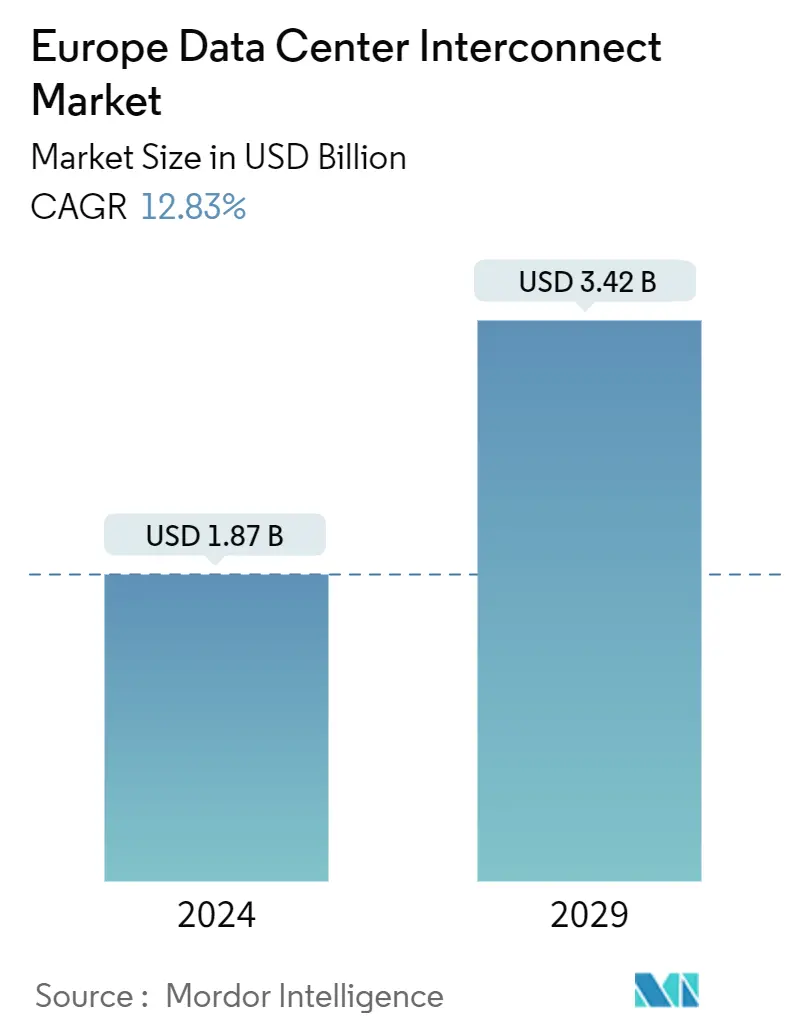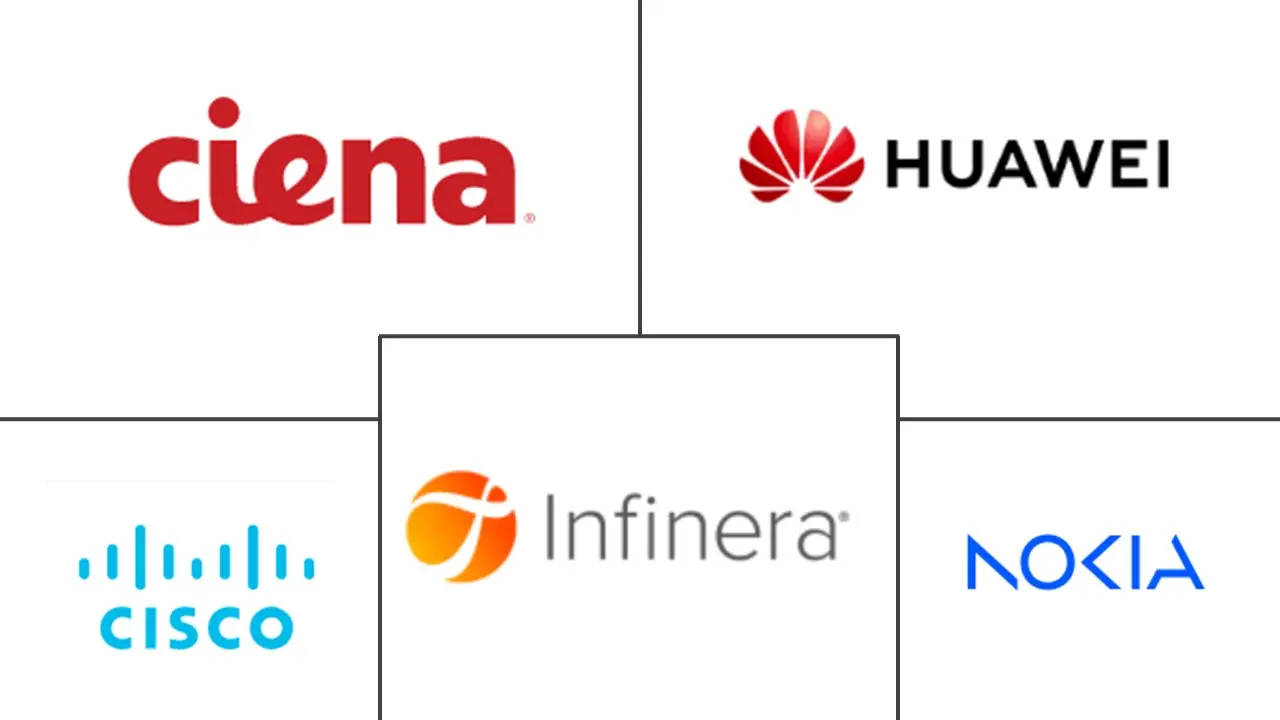Market Size of Europe Data Center Interconnect Industry

| Study Period | 2019-2029 |
| Base Year For Estimation | 2023 |
| Market Size (2024) | USD 1.87 Billion |
| Market Size (2029) | USD 3.42 Billion |
| CAGR (2024 - 2029) | 12.83 % |
| Market Concentration | Medium |
Major Players
*Disclaimer: Major Players sorted in no particular order |
Europe Data Center Interconnect Market Analysis
The Europe Data Center Interconnect Market size is estimated at USD 1.87 billion in 2024, and is expected to reach USD 3.42 billion by 2029, growing at a CAGR of 12.83% during the forecast period (2024-2029).
With the proliferation of data and expansion of technologies like AI and high-performance computing (HPC), the need to connect data center assets quickly, reliably, and cost-effectively is growing significantly. Factors such as throughput, latency, simplified operations, maintenance, intelligence, and security are becoming significant priorities for data center vendors. This is one of the major factors driving the adoption of data center interconnect (DCI) technology, owing to its ability to boost inter-data center bandwidth, reduce latency, and eliminate packet loss.
- Government agencies offer tax breaks and other benefits to attract the maximum number of investors to construct a hyperscale data center market in Western Europe & the Nordics. Due to vast resources of renewable energy, low power prices, favorable climate conditions, good infrastructure, and a skilled workforce, Nordic countries are well suited for data centers and, therefore, for DCI and have resulted in a surge of foreign investments over the years.
- The market studied is expanding due to the growing cloud computing industry and the recent increase in OTT service use due to a nationwide shutdown. Furthermore, introducing 5G services may broaden the scope of interconnected data center solutions. Autonomous cars, smart cities, digital twins, virtual reality, AI virtual assistants, video surveillance and monitoring, and gaming are fueling market demand.
- Cloud computing is one sector estimated to be a significant driver of the data center interconnect market. Cloud computing has been increasing over the past few years, owing to lower operational expenses faced by enterprises. Combining colocation with the cloud can reduce latency, increase security, and create cloud interconnection opportunities. Cloud provider companies require high bandwidth and resiliency private networks and support from a robust data center provider.
- The major challenge, especially for small and medium-sized businesses, is the cost of data center connectivity services. A new data center necessitates a significant investment in both construction and maintenance. Furthermore, the distance between data centers is important since it might reduce a data center's efficiency, limiting the growth of the data center interconnect industry.
- The fast growth of online activity has raised the demand for data center interconnection, particularly in recent years, as the COVID-19 pandemic made access to internet applications a requirement. With more people relying on the Internet for work, social networking, e-commerce, banking, and entertainment, the demand for almost limitless uptime and interconnection is growing.
Europe Data Center Interconnect Industry Segmentation
The data center interconnect (DCI) technology connects two or more data centers together over short, medium, or long distances using high-speed packet-optical connectivity. Some large operations use DCI to connect their own data centers within their extended enterprise infrastructures, while others connect to partners, cloud providers, or data center operators to enable simpler data and resource sharing or to handle disaster recovery needs. The market study focuses on end-user industries utilizing DCI to address space and power challenges.
The European data center interconnect market is segmented by country (Germany, United Kingdom, France, Ireland, Spain, Rest of Europe). The market sizes and forecasts are provided in terms of value in USD for all the abovementioned segments.
| By Country | |
| Germany | |
| United Kingdom | |
| France | |
| Ireland | |
| Spain | |
| Rest of Europe |
Europe Data Center Interconnect Market Size Summary
The European data center interconnect market is experiencing significant growth, driven by the increasing demand for rapid and reliable connectivity solutions amid the proliferation of data and advancements in technologies such as AI and high-performance computing. The need for enhanced inter-data center bandwidth, reduced latency, and improved security is propelling the adoption of data center interconnect (DCI) technology. The market is further bolstered by government incentives in regions like Western Europe and the Nordics, which attract investments in hyperscale data centers due to favorable conditions such as renewable energy resources and a skilled workforce. The expansion of cloud computing and the rise in over-the-top (OTT) services, accelerated by the COVID-19 pandemic, are also contributing to the market's growth, as they necessitate robust interconnection solutions to support increased online activity and data traffic.
In Germany, the demand for data center interconnect solutions is fueled by the country's digital transformation, the adoption of cloud computing, and the implementation of stringent data protection regulations like GDPR. The development of edge computing and the rollout of 5G networks are further driving the need for high-capacity, low-latency networks. The telecommunications sector holds a significant market share, benefiting from the growing need for enhanced connectivity and reduced data transfer latency. Major players in the market, including Huawei Technologies, Ciena Corporation, Cisco Systems Inc., Infinera Corporation, and Nokia Corporation, are actively expanding their offerings through strategic partnerships and investments. The market's semi-consolidated nature allows these companies to leverage their expertise and resources to meet the increasing demand for interconnected data centers across Europe.
Europe Data Center Interconnect Market Size - Table of Contents
-
1. MARKET INSIGHTS
-
1.1 Market Overview
-
1.2 Industry Attractiveness - Porter's Five Forces Analysis
-
1.2.1 Bargaining Power of Suppliers
-
1.2.2 Bargaining Power of Consumers
-
1.2.3 Threat of New Entrants
-
1.2.4 Threat of Substitutes
-
1.2.5 Intensity of Competitive Rivalry
-
-
1.3 Assessment of the Impact of COVID-19 on the Industry
-
-
2. MARKET SEGMENTATION
-
2.1 By Country
-
2.1.1 Germany
-
2.1.2 United Kingdom
-
2.1.3 France
-
2.1.4 Ireland
-
2.1.5 Spain
-
2.1.6 Rest of Europe
-
-
Europe Data Center Interconnect Market Size FAQs
How big is the Europe Data Center Interconnect Market?
The Europe Data Center Interconnect Market size is expected to reach USD 1.87 billion in 2024 and grow at a CAGR of 12.83% to reach USD 3.42 billion by 2029.
What is the current Europe Data Center Interconnect Market size?
In 2024, the Europe Data Center Interconnect Market size is expected to reach USD 1.87 billion.

